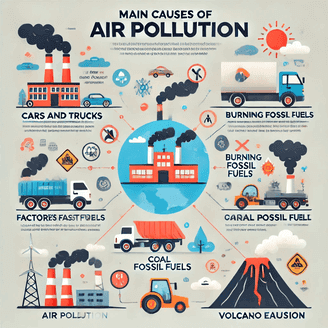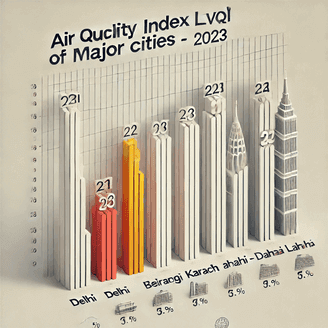Introduction
Have you ever stepped outside, taken a deep breath, and felt the air was heavy or smelled strange? Maybe you’ve noticed a haze hanging over the city skyline, or your eyes start to water after spending time outdoors. That uncomfortable feeling could be caused by air pollution—tiny particles and harmful gases floating invisibly in the air you breathe.
Air pollution isn’t just an inconvenience. It is a serious, growing problem that affects your health, the environment, and the climate. Even if you can’t see it, polluted air can silently damage your lungs, heart, and the planet we all share.
In this guide, we’ll explore what air pollution is, where it comes from, seven of the most shocking ways it affects us, and the practical steps you can take to protect yourself and contribute to cleaner air.
This invisible pollution includes smog, fine particulate matter like PM2.5, and airborne toxins that can damage your health without you realizing it.

Table of Contents
What Is Air Pollution?
Air pollution happens when harmful substances—such as chemicals, gases, and fine particles—contaminate the air around us. These pollutants can be produced by human activities, such as driving cars, burning coal, and operating factories, or they can occur naturally through processes like wildfires and volcanic eruptions.
According to the World Health Organization, air pollution causes approximately 7 million premature deaths annually. It is considered one of the biggest environmental health threats of our time.
What Causes Air Pollution?
Air pollution has many sources. Some are naturally occurring, but most are caused by human activities. Here are some of the main contributors:
1. Cars, Trucks, and Buses
Every day, millions of vehicles burn petrol and diesel, releasing exhaust fumes filled with pollutants like nitrogen oxides (NOx), carbon monoxide (CO), and particulate matter (PM2.5). These pollutants don’t just disappear—they linger in the atmosphere and settle into our lungs.
Example:
In Delhi, India, a combination of traffic emissions and construction dust often causes the air quality to drop to hazardous levels, making it difficult to breathe, especially for children and older adults.
These emissions are the main cause of smog and ozone pollution in urban areas.
2. Factories and Industrial Activity
Factories and power plants are major sources of air pollution. When industries burn fossil fuels to produce energy or manufacture goods, they emit large amounts of smoke and chemical byproducts into the atmosphere.
Example:
Cities like Beijing in China have battled severe smog due to industrial emissions, sometimes forcing schools to close and residents to stay indoors for days.

3. Burning Coal, Oil, and Gas
Generating electricity through coal and oil remains common in many countries. Unfortunately, burning these fuels releases massive amounts of carbon dioxide (CO₂), sulfur dioxide (SO₂), and other toxins.
Tip:
Switching to renewable energy sources like solar and wind power is one of the most effective ways to reduce this form of pollution.
4. Natural Sources
Not all air pollution is man-made. Nature also plays a role:
- Volcanoes erupt, releasing ash and sulfur gases.
- Wildfires create dense smoke that can travel thousands of kilometers.
- Dust storms lift fine particles into the air, reducing visibility and air quality.
Although we can’t prevent natural events, we can reduce human-made pollution to improve overall air quality.
Wildfires and dust storms can release large amounts of PM2.5 and other fine particles into the air, worsening outdoor and indoor air pollution.
7 Shocking Effects of Air Pollution
Air pollution is more than just an eyesore—it causes serious harm to health, the environment, and our climate. Here are seven of the most alarming effects:
1. Respiratory and Cardiovascular Diseases
Breathing polluted air irritates your airways and makes your lungs work harder. Over time, exposure can lead to chronic bronchitis, asthma, lung cancer, and heart disease.
Fine particulate matter such as PM2.5 can penetrate deep into the lungs and enter the bloodstream, triggering severe respiratory illnesses.
Real Example:
During the “Great Smog” in London in 1952, toxic air led to the deaths of an estimated 4,000 people within a few days.
“The United Nations Environment Programme (UNEP) states that poor air quality contributes to severe health issues, including respiratory and cardiovascular diseases.”

2. Children’s Health and Development
Children are especially vulnerable because they breathe faster and their bodies are still developing. Exposure to polluted air has been linked to lower birth weights, developmental delays, and lifelong respiratory issues.
Quote:
“The United Nations Environment Programme (UNEP) reports that children exposed to air pollution are at higher risk of asthma and cognitive impairments.”
3. Premature Death
The World Health Organization estimates that 7 million people die prematurely every year due to exposure to air pollution. Many of these deaths are linked to strokes, heart attacks, and lung diseases.
4. Damage to the Environment
Air pollution doesn’t just harm people—it also hurts wildlife and ecosystems.
- Acid Rain: Pollutants mix with rainwater, creating acid rain that damages forests, soils, and lakes.
- Crop Damage: Ozone in the lower atmosphere harms plant growth, reducing food security.
The environmental impact of pollution includes acid rain, loss of biodiversity, and damage to critical ecosystems.
5. Climate Change Acceleration
Certain pollutants, such as carbon dioxide and methane, trap heat in the atmosphere. This “greenhouse effect” is a major driver of global warming, which leads to extreme weather, rising sea levels, and melting glaciers.
Fact:
According to the International Energy Agency (IEA), burning fossil fuels accounts for about 75% of greenhouse gas emissions worldwide.
6. Reduced Visibility and Quality of Life
Smog-filled air obscures skylines, ruins natural beauty, and reduces the quality of life. In some cities, air pollution limits outdoor activities, tourism, and economic growth.
7. Damage to Buildings and Infrastructure
Airborne chemicals and particles can corrode buildings and monuments. Historic structures made of limestone or marble are particularly vulnerable to acid rain.
Air pollution doesn’t just make the air dirty. It can hurt our health, the environment, and even the climate. Let’s break it down:
How Can We Reduce Air Pollution?
The problem may seem overwhelming, but there are practical steps you can take to help reduce air pollution:

1. Use Clean Energy
Switching to renewable energy sources is one of the most effective ways to cut pollution.
- Install solar panels on your home.
- Choose green energy providers that use wind or hydro power.
- Support policies and programs that fund clean energy projects.
Example:
Germany’s transition to renewable energy (the “Energiewende”) has dramatically increased the share of solar and wind power in its electricity grid.
Switching to renewable energy also reduces ozone pollution and cuts down the amount of particulate matter in the air.
2. Drive Less and Drive Smart
Transportation contributes significantly to air pollution. You can help by:
- Walking or cycling for short trips.
- Using public transport or carpooling.
- Choosing hybrid or electric vehicles.
- Avoid idling your car unnecessarily.
Tip:
When you plan errands efficiently, you reduce the number of trips and save fuel.
3. Plant and Protect Trees
Trees act as natural air filters by absorbing carbon dioxide and releasing oxygen.
- Join community tree-planting initiatives.
- Protect green spaces in your neighborhood.
- Grow air-purifying plants indoors.
Example:
Kenya’s “Green Belt Movement” has planted over 50 million trees, improving air quality and empowering communities.
4. Reduce, Reuse, Recycle
Waste incineration releases harmful pollutants. Reducing waste helps cut emissions.
- Use reusable bags, bottles, and containers.
- Recycle paper, metal, and plastic.
- Buy products with minimal packaging.
“The International Energy Agency (IEA) highlights that transitioning to electric vehicles is a vital step in reducing transportation emissions.”
5. Conserve Energy
Reducing your electricity use also means fewer fossil fuels burned.
- Switch to LED lighting (uses 75% less energy).
- Unplug electronics when not in use.
- Set your thermostat wisely.
6. Support Cleaner Industry Practices
As a consumer, you have the power to demand change:
- Buy from companies committed to sustainable manufacturing.
- Support brands that invest in clean technology and emissions reductions.
- Advocate for stricter pollution controls in industries.
7. Educate and Advocate
Spreading awareness is key to change.
- Share articles and resources with friends and family.
- Participate in community meetings about air quality.
- Vote for policies and leaders prioritizing clean air initiatives.

Air Pollution in Numbers
Here are some facts and figures to help you understand the scale of the problem:
- 7 million deaths per year are caused by air pollution.
- 80% of the world’s energy still comes from fossil fuels.
- India, China, and Pakistan are among the countries with the poorest air quality.
- In 2023, Delhi’s average Air Quality Index (AQI) reached 180, which is considered unhealthy.
Let’s look at some facts to understand how big the problem is:

Bar Graph: Air Quality Index (AQI) in Major Cities (2023)

Note: AQI above 100 is unhealthy.
FAQs About Air Pollution
What exactly is air pollution?
Air pollution means the presence of harmful substances—like gases, chemicals, and fine particles—in the air we breathe. These pollutants can come from cars, factories, burning fossil fuels, and even natural events like wildfires and volcanoes.
Why is air pollution dangerous to human health?

Breathing polluted air can irritate your lungs and airways. Over time, it increases the risk of serious health problems such as asthma, chronic bronchitis, lung cancer, heart disease, and stroke. Children, older adults, and people with existing health issues are especially vulnerable.
How does air pollution contribute to climate change?
Certain air pollutants, such as carbon dioxide and methane, act like a blanket around the Earth, trapping heat and causing the planet to warm. This warming leads to extreme weather, rising sea levels, and damage to natural ecosystems.
Can air pollution affect indoor air quality?
Yes. Indoor air can be polluted by tobacco smoke, cooking fumes, chemicals from cleaning products, and even mold. Proper ventilation and using clean fuels can help improve indoor air quality.
What is the Air Quality Index (AQI), and how do I check it?
The Air Quality Index is a scale from 0 to 500 that tells you how clean or polluted the air is. A higher AQI means more pollution and greater health risks. You can check your local AQI on government websites, weather apps, or environmental monitoring services.
What countries have the worst air pollution?
Countries with rapidly growing cities and heavy reliance on coal or diesel fuel—like India, China, and Pakistan—often have the highest levels of air pollution. However, pollution can occur anywhere, especially in densely populated or industrial areas.
Are masks effective against air pollution?
Simple cloth or surgical masks are not very effective at filtering fine particles (PM2.5). For better protection, you can use N95 or FFP2 masks, which are designed to filter out most airborne pollutants.
Can air pollution be reversed or improved over time?
Yes. When emissions are reduced through clean energy, better regulations, and sustainable practices, air quality can improve significantly. Many cities have seen dramatic improvements after implementing stricter pollution controls.
What is PM2.5, and why is it dangerous?
PM2.5 refers to tiny particles smaller than 2.5 micrometers in diameter. Because of their size, they can bypass your body’s natural defenses, lodge deep in your lungs, and even enter your bloodstream, leading to serious health problems like heart disease and respiratory illnesses.
Conclusion
Air pollution may seem like an impossible problem to solve, but every action you take matters. Whether you choose to drive less, switch to clean energy, or plant trees, you are contributing to a healthier environment for everyone.
👉 You might also like:
Call to Action:
Air pollution is a crisis we can’t ignore. Start today by sharing this guide, educating others, and making small changes in your own life. Together, we can clear the air and create a more sustainable future.
About the Author
Soumen Chakraborty is an environmental writer dedicated to making complex environmental issues understandable and actionable. He believes that small changes, when multiplied, can transform the world.
Last update on 06 July 2025
💬 What do you think? Share your thoughts in the comments!

